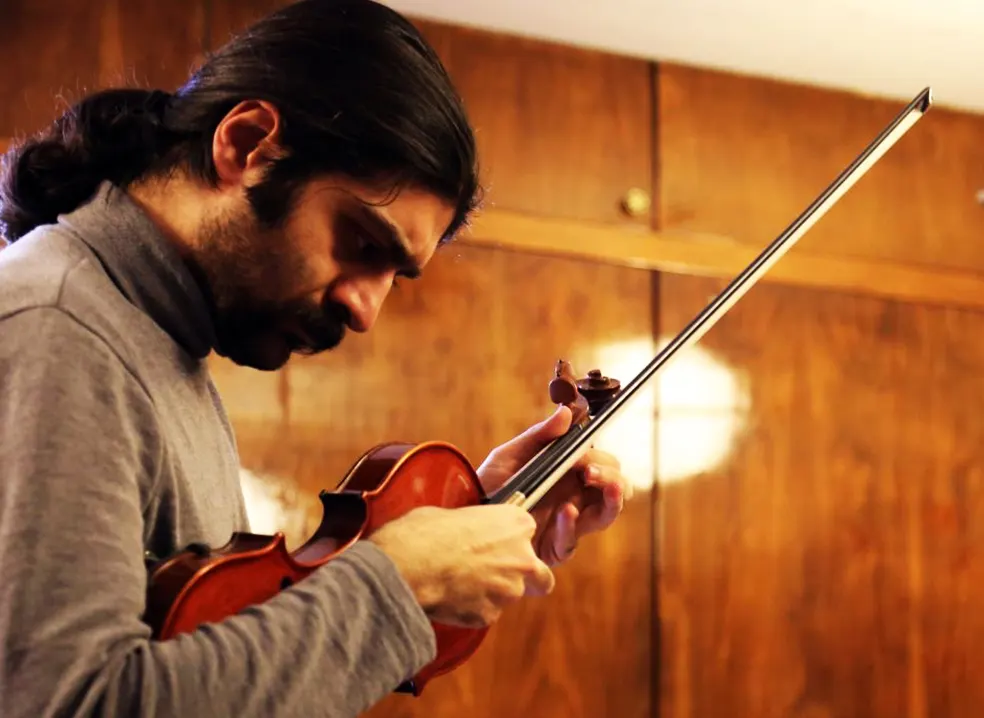Folk N Rock
Spotlight Album: ‘The Last Knight’ – Soheil Salimzadeh
One of the best things about music is its ability to transcend genres, creating something entirely new and unexpected in the process. That’s the very spirit that led to the creation of this site, a celebration of those fusions – especially when they involve the beloved melodies of Celtic music.
While Celtic punk and Celtic metal have long held a special place in our hearts, sometimes it’s the most unanticipated combinations that leave the most lasting impression. “The Last Knight” is one such experience. This album goes into the electrifying possibilities that arise when Celtic tunes intertwine with both the richness of orchestral music and the raw energy of a little bit of rock.
The mastermind behind the album, Soheil Salimzadeh, an Iranian composer, violinist, and conductor known for his work in classical, oriental, and gypsy music. He has performed as both a soloist and a member of orchestras, and has released two albums – “Sari Gelin” and the focus of our review today, “The Last Knight.” Salimzadeh’s diverse background makes him the ideal creator for a project like this, and the results are nothing short of amazing.
The opening track, “9th’s Farewell to Gibraltar,” throws the you in headfirst into a whirlwind of re-imagined tradition. Composed by Pipe Major John Macdonald in 1848, this well-known piece takes on a completely new life here. A warm fiddle melody establishes the Celtic heart of the song from the very first note.
It’s a sound that felt like it took me into the misty morning in the heart of the Highlands. This opening gets a swift jolt of energy with the addition of a pounding drumb shortly after. And the delicate chime makes its way through the background, adding a touch of the whimsy to the scene.
The familiar military snare enters the mix, reminding me that even with all the new textures, the song’s traditional roots remain firmly in place. The flute then takes center stage, adding a fluttering layer atop the steady drumbeat and the fiddle’s persistent melody. The combination is absolutely enchanting, a sea of sound that mixes together the old and the new with remarkable ease.
Around 40 seconds in, the tempo downshifts, creating an soft little space for the fiddle to shine. But the triumphant feeling returns almost as quickly as it vanishes, carried back in by the surging orchestra. This flow of intensity really kept me engaged, unsure of what sonic turn the piece might take next.
As the track approaches the 2:30 mark, the intensity ratchets up considerably. The violin section takes on an almost frenetic energy that put me in mind of a surprising source: punk rock. Joe Strummer, the legendary frontman of The Clash, once praised the Celtic punk band The Pogues, calling their music deceptively difficult to play. Their breakneck tempos and triplet-heavy melodies share a kinship with the blistering violin work I’m hearing here, and throughout the album.
And for me, this is a reminder that tradition and innovation can sometimes occupy the same space, creating something truly special. This connection isn’t purely academic; the frenetic energy of the violin section evokes the raw power of rock, a jolt of electricity that jolts you out of any complacency and underscores the power of the original melody.
The intensity of this section, as well as similar moments scattered throughout the album, reminded me of the inherent challenges of Celtic music. All those rolls, cuts, and triplets that add such melodic richness? They’re surprisingly difficult techniques to master. It takes incredible practice and finesse to execute them properly, and the violin work on this album is a clear demonstration of that skill. This opening track does a great job of showcasing both the accessibility and the complexity of traditional melodies, all while breathing new life into them.
On that note, I can’t think of a better way to kickstart this album. This cover of “9th’s Farewell to Gibraltar” has become a new favorite. It respects the familiarity of the classic tune yet surprises me with its bold arrangements and unexpected influences.
Archibald MacDonald of Keppoch’ is another traditional pipe tune that I’m familiar with. I’ve enjoyed a previous version with fiddle and cello, and that mournful, sorrowful atmosphere is still very much present here. However, this rendition offers a slightly different perspective on the melody while maintaining its melancholic core.
The violin work carries the primary theme, accompanied by a pennywhistle that calls to mind the instrument’s historical connection to pipes. There’s an almost medieval feel to the piece, bolstered by a hint of something akin to a harpsichord lingering in the background, adding a touch. And I have to say, I really love this approach.
Right before the one-minute mark, the full orchestra enters the scene, bringing a surge of unexpected richness to the arrangement. I particularly enjoy the plucked strings, adding a rhythmic undercurrent that works beautifully in tandem with the sustained melodies. Then, at roughly 1:22, a big crescendo sweeps in, only to subside just as quickly.
It’s a brief yet powerful moment, and I find the overall arrangement wonderfully done. The way the musicians brings together these traditional elements with the orchestral flourishes creates a truly version of this song I’ve never heard before.
“Haste to the Wedding,” one of the most beloved Irish jigs of all time, gets a revitalizing injection of energy here. The traditional instrumentation is all there – I definitely pick up on what I think is the bodhran and other percussive elements – but the bassline steals the show for me.
It’s incredibly infectious, adding a modern groove to the familiar melody that had me tapping my foot before I even realized it. The latter half of the song amps up the intensity with those thunderous layers of percussion. It’s a quick hit of pure joy, made even more potent by the way it merges traditional instrumentation with that undeniable contemporary kick.
I particularly appreciate how the use of those modern touches doesn’t overwhelm the classic jig. It’s still recognizably “Haste to the Wedding,” just with a dash of extra spice. Fantastic work by on this track.
Morrison’s Jig” stands out as a truly breathtaking piece. The opening violin solo is a masterclass in emotional delivery. Its sorrowful melody establishes an emotional atmosphere that drew me in. There’s an undeniable melancholic beauty infused into those notes, likely influenced by the choice of E minor as the key for the piece in the original. Those signature casts a long shadow over the entire track, coloring the melody with its inherent yearning, a characteristic quality that is particularly well-suited to the lamenting spirit of the jig.
The fusion with the orchestral elements is where this track truly shines for me. It builds gradually into something epic, almost cinematic in its scope and intensity. The interplay between the delicate Celtic melody and the sweeping orchestrations is so, so good, a constant push and pull between intimacy and grandeur. And out of nowhere this surges of intensity create moments of dramatic tension, balanced by moments of quiet parts that allow the beauty of the melody to shine through.
The arrangements feel absolutely masterful. The way it weave together these traditional elements creates an amazing array of sound yet agaain. I find myself hitting repeat on “Morrison’s Jig” obsessively – it’s simply one of the most compelling tracks for me on the album, as I’ve always loved this song.
“O Gin I Were A Baron’s Heir” takes its place among the many interpretations of this classic ballad, each with its own subtle variations in lyrics and melody. At its core, the song tells a timeless tale of love conquering all – true love that transcends social standing and material wealth. Traditionally played in a minor key, the melody carries a wistful melancholic air, like some of the other numbers.
This rendition opens with a beautiful interplay between pipes and a bed of lush strings. The way they intertwine and harmonize creates a truly amazing sound, and you don’t need lyrics, the music itself will draw you into its story. While the song has always held a certain emotional weight, here, it reaches a whole new level. Around the halfway mark, a moment arrives that really gave me goosebumps. The orchestrations surge to the forefront, creating a wave of intensity that is both breathtaking and deeply moving.
The album closes on a high note with “The Kesh Jig,” a traditional Irish reel known for its infectious energy and playful melody. This lively tune typically adheres to that classic 6/8 time signature, with its signature ascending and descending phrases. As a huge fan of this musical effect, I was particularly excited to hear this track reimagined for orchestra and Celtic instrumentation. The fusion of these two genres is truly a highlight of the entire album for me personally, and “The Kesh Jig” exemplifies it beautifully.
The track opens with a gentle harp, setting a delicate and atmospheric stage. A humming ambience hangs in the background, adding a touch of mystery before the fiddle makes its entrance. Shortly thereafter, the rest of the orchestral elements join the party, creating a rich sea of sound that perfectly complements the melody.
While all the songs on this album are fantastic, “The Kesh Jig” holds a special place in my heart. It truly showcases the talents of the primary violin, but what really elevates the track for me is the cool interplay between the instruments. Here’s where things get interesting: a whimsical chime appears out of nowhere, flitting around the melody like a magical sprite.
This addition adds a touch of enchantment before transitioning to the other strings. This handoff between the violin and the other string instruments creates a wonderful moment of transition, a detail I absolutely love that effect.
Around the 1:15 mark, the track takes a turn. It dives headfirst into a rocking detour. The percussion comes into action, giving the piece an irresistible rock-and-roll vibe along with the rest of the arrangement. This twist was done so well, and the percussion work throughout this section is simply outstanding. I absolutely love this track.
Sometimes, an artist’s talent transcends the limitations of language. The knowledge, skill, and sheer creative vision required to bring a project like “The Last Knight” to life are almost overwhelming to contemplate, even for those of us who have spent years delving into the intricacies and beauty of music.
Soheil Salimzadeh’s work here is nothing short of brilliant, and attempting to analyze it feels almost as futile as a novice chef trying to describe the symphony of flavors and aromas that dance across the palate in a Michelin-starred dish. Appreciating the artistry behind such a complex creation requires a different kind of engagement, a surrendering to the experience itself. And what an experience it is.
The familiar melodies of Celtic music take on a whole new life, imbued with the richness of orchestral arrangements and the raw energy of hint a hint of rock. The result is an incredible album of Celtic music and the possibilities that arise when it ventures into uncharted territory. This is, without a doubt, a five-star album, a must-listen for anyone who appreciates music that pushes boundaries and redefines genres.
The post Spotlight Album: ‘The Last Knight’ – Soheil Salimzadeh appeared first on Folk N Rock.
Scott




